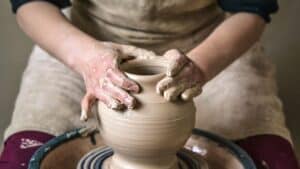Enamel paint is a solvent-based paint that dries to a hard, glossy finish, making it a favorite for airbrush artists looking to create eye-catching art.
Paint must be a certain consistency to be used effectively in an airbrush, and enamel paint should be thinned before putting it in an airbrush.
This article will teach you everything you need to know to properly thin enamel paint for use in an airbrush.
- Supplies Needed
- 1. Put on Safety Gear and Set Up Work Area
- 2. Pour Paint in Bucket
- 3. Add Thinner to the Paint
- 4. Strain the Thinned Paint
- 5. Test the Paint
- Best Enamel Paint for Airbrushing: Testors
- Guidelines for Airbrushing Enamel Paints
- Safety Precautions for Airbrushing Enamel Paints
- How To Clean Airbrush After Using Enamels
- Do You Need To Thin Enamel Paint for Airbrush?
- What Do You Use To Thin Enamel Paint?
- Enamel Paint Thinner Ratio
- Conclusion
Supplies Needed
- Airbrush and compressor
- Enamel paint
- Paint thinner of choice
- Two buckets
- A paint stick for mixing
- Gloves
- Paint respirator or mask
- Goggles
- Funnel or paint strainer
- An apron
- A tarp or drop cloth
- A piece of cardboard
1. Put on Safety Gear and Set Up Work Area
Enamel paint can emit toxic fumes that can be harmful to your health. If you can, it’s best to work outside when using enamel paint, especially when it comes to airbrushing.
If you can’t work outdoors, make sure to open doors and windows and turn on a fan to create a well-ventilated work space.
You will also want to wear protective gear. A mask offers negligible protection, but a respirator made for painters can help you to protect your lungs from paint particles.
Gloves and an apron can protect your hands and clothing, and goggles can provide eye protection.
It’s a good idea to put down a tarp or drop cloth to protect the area you are working in from accidental spills as enamel paint is extremely durable once it dries and can be quite challenging to remove.
2. Pour Paint in Bucket
Open the paint, and pour it through the strainer and into the bucket. The strainer will keep any impurities out of your paint.
You only need to pour the amount of paint that you intend to use into the bucket.
3. Add Thinner to the Paint
Follow the instructions on the label of the thinner, and mix it into the paint. Stir the thinner into the paint for several minutes until you get a consistency that is similar to that of milk.
Make sure to use the right thinner for the type of paint you are using.
If you are using a water-based enamel paint, you can use water as a thinner; otherwise you will want to use a solvent such as mineral spirits as your paint thinner.
4. Strain the Thinned Paint
Use the strainer to pour the thinned paint into a second bucket, ensuring that there are no clumps in the paint.
5. Test the Paint
Pour a little bit of paint into the airbrush and test it by spraying it onto the cardboard. The paint should spray smoothly through the airbrush and not leave an uneven spray pattern.
An uneven spray pattern means that the paint has not been correctly thinned.
Best Enamel Paint for Airbrushing: Testors
Testors Enamel Paint Set comes with 8 different colors of paint, as well as 1 bottle of paint thinner, a brush, and a tray.
It is a high-quality, easy-to-use set for beginners and professional airbrushers alike.
Guidelines for Airbrushing Enamel Paints
You want to make sure to thin the enamel paint before putting it in your airbrush, otherwise the paint can clog your airbrush, leading to uneven spray patterns and other issues.
You will also need to properly clean out your airbrush after using it with enamel paints.
Safety Precautions for Airbrushing Enamel Paints
Enamel paints can contain volatile organic compounds (VOCs) that can be toxic and have harmful effects on your health.
To protect yourself and stay safe, it’s always a good idea to work in a well-ventilated area (or ideally outdoors) when airbrushing with enamel paints.
You should also wear protective gear, such as gloves, goggles, an apron, and a mask or respirator (this is good one at a great price) when airbrushing with enamel paints.
How To Clean Airbrush After Using Enamels
You want to clean your airbrush immediately after spraying with enamel paints, as these paints can harden quickly and become extremely difficult to remove once dry.
First, you will want to spray any remaining paint out of the airbrush and into a trash bag or rags.
Then use paper towels or shop towels dipped in lacquer thinner or mineral spirits to clean the outside of the airbrush.
Next fill the airbrush bowl with thinner, and spray it through the airbrush until it sprays clear. Then take the needle out of the airbrush and clean it with thinner.
If you want to deep clean your airbrush, you can disassemble it and soak all of the parts except for the air valve in the thinner for an hour.
The air valve has nitrile rubber seals which can degrade when exposed to paint thinners.
Use cotton balls or pipe cleaners dipped in thinner to remove any paint that remains on the airbrush parts after the hour is up.
Then use a non-reactive, non-drying airbrush lubricant to lubricate the needle, threaded sections, and trigger. You can then reassemble your airbrush and polish it with a dry cloth.
Do You Need To Thin Enamel Paint for Airbrush?
You don’t have to thin enamel paint before airbrushing, but if you choose not to, the paint can clog up or damage your airbrush.
If the enamel paint you are using is already a milk-like consistency, you do not need to thin it.
What Do You Use To Thin Enamel Paint?
To thin enamel paint, you can use water if the enamel paint is water based or mineral spirits for oil-based enamel paints.
You want to avoid using alcohol, turpentine, or lacquer thinner to thin enamel paint for use with your airbrush.
Can You Thin Enamel Paint With Turpentine?
You technically can use turpentine to thin enamel paint, but it is not recommended as it speeds up the drying time of the paint.
Turpentine is better used for cleaning oil-based enamel paint from your airbrush after spraying.
Can You Thin Enamel Paint With Water?
You can use water to thin enamel paint as long as the paint is water based.
Enamel Paint Thinner Ratio
You should follow the instructions on the label of the thinner, but in most cases you will mix enamel paint at a 3:1 ratio, with 3 parts paint to 1 part thinner.
The key thing is to mix the thinner and the paint until you get a milk-like consistency and to make sure that you always use more paint than thinner.
Conclusion
Enamel paint dries hard and shiny, creating a durable shell that looks lustrous and professional.
The downside is that its durability means that it can be quite difficult to remove when dry, which is why you want to keep your airbrush and surrounding area clean while you’re spraying and make sure to deep clean your airbrush after spraying with enamel paint.
It’s also important to make sure that your enamel paint is properly thinned before using it in your airbrush.
If you don’t thin the enamel paint, it can clog and damage your airbrush or lead to an uneven spray pattern.








